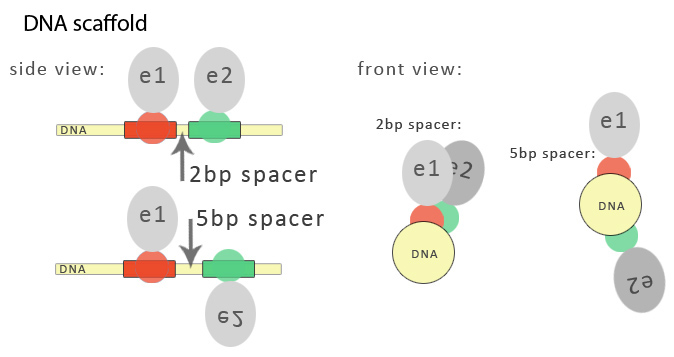Team:Slovenia/PROJECT/proof/program
From 2010.igem.org
What is a DNA program?
DNA program is a noncoding DNA sequence consisting of specific binding sites for DNA binding domains. These DNA binding domains can be linked to functional domains (e.g. enzymes). This is analogous to the recognition of RNA codons by anticodons on aminoacyl tRNA, where the aminoacyl tRNA corresponds to the DNA binding domain with functional protein domain. When those functional domains assemble on a DNA program they are brought closer together in a defined order. By changing the places of binding sites on a DNA program it is possible to change the sequence of events (e.g. course of the reaction in case of the enzymes).
Selection and importance of spacer sites
Binding sites for three-fingered zinc fingers span 9 nucleotides but can be extended to 18 base pair recognition motifs for longer zinc fingers, spanning from one to two DNA duplex helical turns, respectively. Binding sites for DNA-binding proteins are separated by spacers, which are nucleotides that are not occupied by DNA-binding proteins. The length of the spacer sequence is not coincidental. The selection follows three dimensional structure of a DNA molecule. One turn of DNA helix is 10,5 base pairs long, which roughly overlaps with the length of a DNA molecule encircled by one zinc finger domain recognising and binding to 9 base pairs. In order to have functional units on the same side of a DNA molecule serving as a DNA program, it is of high importance to select the right spacer length. This is the case when having split functional units attached to DNA binding domains as well as when biosynthetic enzymes are selected for functional domains. Double helix of DNA defines on which side of the helix the functional domain will be attached, which is defined by the length of the spacer between DNA domain binding sites: spacer of 1 or 2 nucleotides positions them very close, while the spacer of five nucleotides positions the neighboring two functional domains to the opposite sides of the helix.
Selection and importance of spacer sites
 "
"
